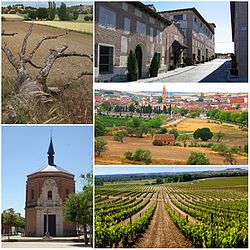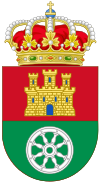
Valladolid is a province of northwest Spain, in the central part of the autonomous community of Castile and León. It has a population of 520,716 people in a total of 225 municipalities, an area of 8,110 km2 (3,130 sq mi) and a population density of 64.19 people per km2.

Peñafiel is a town in the Valladolid Province and the greater autonomous community of Castile and León, Spain. It is best known for the Peñafiel Castle and for its medieval square used for bullfights and named "Plaza del Coso". The square is surrounded by private homes, but since medieval times the rights to use their windows, balconies and doorways during bullfights are owned by the town, which auctions them to the highest bidders.

Ribera del Duero is a Spanish Denominación de Origen Protegida (DOP) located in the country's northern plateau and is one of eleven 'quality wine' regions within the autonomous community of Castile and León. It is also one of several recognised wine-producing regions to be found along the course of the Duero river.

Curicó Province is one of four provinces of the central Chilean region of Maule (VII). Its capital is the city of Curicó. It lies between the provinces of Colchagua and Talca and extends from the Pacific to the Argentine frontier, spanning an area of 7,280.9 km2 (2,811 sq mi). According to the 2002 census, the population was 244,053.
The Abadia Retuerta is a Spanish winery founded in 1996. The estate is situated just outside the border of the Ribera del Duero region in Spain’s north central province of Castilla y León, near the village of Sardón del Duero. Twenty miles east of the city of Valladolid, it lies in wine estates stretching from Tudela de Duero to Peñafiel known as “the golden mile”. Notably, it is just a few miles from Vega Sicilia, producer of Unico (wine).

Calatayud is a Spanish Denominación de Origen Protegida (DOP) for wines located in the southwestern corner of the province of Zaragoza about 90 km from Zaragoza and covers over 5,600 ha, extending over 46 different municipalities, including Calatayud itself. It borders with the Cariñena (DO) in the east and with the province of Soria in the west. It is in the Ebro River valley and is crisscrossed by many of the Ebro's tributaries including the Jalón, Jiloca, Manubles, Mesa (river), Piedra and Ribota. The vineyards are found on the south facing slopes of the Sierra de la Virgen range at heights of between 550 m and 800 m above sea level.

Campo de Borja is a Spanish Denominación de Origen Protegida (DOP) for wines located in the Campo de Borja comarca, northwest of the province of Zaragoza. It is a transition zone between the plains of the River Ebro and the mountains of the Sistema Ibérico. The DOP comprises 16 municipalities. These are Ainzón, Agón, Albeta, Ambel, Bisimbre, Borja, Bulbuente, Bureta, Fréscano, Fuendejalón, Magallón, Maleján, Mallén, Pozuelo de Aragón, Tabuenca and Vera de Moncayo. The Moncayo mountain is the dominant feature of the DOP and creates a microclimate which gives the wines a special character.

Cigales is a Spanish Denominación de Origen Protegida (DOP) for wines located to the north of Valladolid along both banks of the River Pisuerga.

Cariñena is a Spanish Denominación de Origen Protegida (DOP) for wines located in Cariñena in the province of Zaragoza. It is among the oldest protected growing areas in Europe, the DO having been created in 1932 alongside other Spanish wine regions. Cariñena vineyards are located near the centre of Aragón, about 50 km southwest of Zaragoza, on the Campo de Cariñena plateau. The lower vineyards lie at an altitude of 400 m, rising to 800 m as they approach the Sierra de la Virgen mountains. To the west they border on the Calatayud (DO).

Jumilla is a Spanish Denominación de Origen Protegida (DOP) for wines that extends over the north of the region of Murcia, Spain. The area includes the municipality of Jumilla, from which it takes its name, and the contiguous southeast of the Albacete province in the Castile-La Mancha region. It is one of Spain's leading wine regions.

Alella is a Spanish Denominación de Origen (DO) for wines produced in Maresme county in the province of Barcelona in the Spanish autonomous communities of Catalonia, located on the Mediterranean coast, 15 km to the north of the city of Barcelona.

Rueda is a Spanish Denominación de Origen Protegida (DOP) for wines located in the Community of Castile and León. It comprises 72 municipalities, of which 53 are in the province of Valladolid, 17 are in the north of the province of Segovia, and 2 are in the north of the province of Ávila. It is one of Spain's leading wine regions, and is known primarily for its white wines based on the Verdejo grape.

Pozaldez is a municipality located in the province of Valladolid, Castile and León, Spain. According to the 2004 census (INE), the municipality has a population of 497 inhabitants. The mayor is Eduardo Ibáñez Palacio and has been the mayor since 1991. The town has three significant monuments: two churches and 18th century fountain. A regionally and nationally known personality from Pozaldez was "Luisito de Pozaldez" known as the last jester. Pozaldez is also known for its wines. It is located on the Rueda region, and has great Verdejo wine.

Verdejo is a variety of wine grape that has long been grown in the Rueda region of Spain. The grape originated in North Africa, and was spread to Rueda in about the 11th Century, possibly by Mozarabs. Verdejo was generally used to make a strongly oxidized, Sherry-like wine. In the 1970s, the winemaking company Marqués de Riscal began to develop a fresher style of white wine based on Verdejo with the help of French oenologist Émile Peynaud. In 1980, white wines from the Rueda region were recognized by a Denominación de Origen (DO). Wines labeled Rueda must contain 50% Verdejo; the remainder is typically Sauvignon blanc or Macabeo. Wines designated "Rueda Verdejo" must contain 85% Verdejo, and are often 100% Verdejo.

Tierra del Vino de Zamora is a Spanish Denominación de Origen Protegida (DOP) for wines located in the province of Zamora, Castile and León, Spain. It was officially upgraded from the lower status of QWPSR 2007.

Uclés is a Spanish Denominación de Origen Protegida (DOP) for wines located in the region of Castile-La Mancha, (Spain), around the town of Uclés in the west of the province of Cuenca and in the northeast of the province of Toledo.

Penedès is a Spanish Denominación de Origen Protegida (DOP) for wines in Catalonia, (Spain). Penedès DOP includes all of the Penedès region and municipalities of four other counties: Anoia, Alt Camp, Baix Llobregat and Tarragonès. The area is framed by the coastal hills of the Garraf Massif and the higher inland mountains which skirt the Central Depression.

The gastronomy of the province of Valladolid comprises the meals, their preparation, and the culinary habits of the province of Valladolid. It is based on barbecued and roast food, especially roasted Spanish cuisine. Wines of high quality highlight the meals.
Ribeiras del Morrazo is a Spanish geographical indication for Vino de la Tierra wines located in the autonomous region of Galicia. Vino de la Tierra is one step below the mainstream Denominación de Origen indication on the Spanish wine quality ladder, and mirrors the Vins de pays of French wine.






















